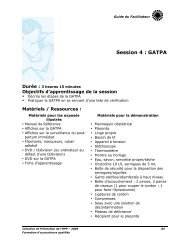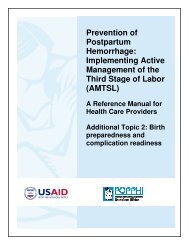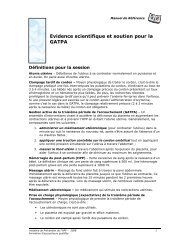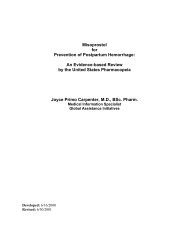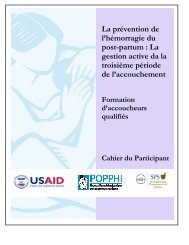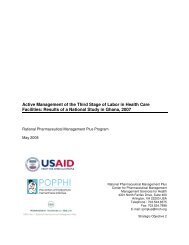English version PDF - POPPHI
English version PDF - POPPHI
English version PDF - POPPHI
Create successful ePaper yourself
Turn your PDF publications into a flip-book with our unique Google optimized e-Paper software.
Card 18Carefully monitor the baby.Keep the mother and baby together. Check the baby at the same timethat the mother is being checked. Before beginning, explain what you are doing to the mother / parents. Ensure the room is warm (25°C). Every 15 minutes during the first 2 hours after delivery of the placenta, you should check the baby’s:– Breathing– Colour– Temperature of the feet (if they are cold, check axillary temperature)– Cord stump for bleeding (retie or tie more tightly if there is bleeding)• Share all findings with the mother / parents. Respond immediately if there are any problems identified.QUESTIONS1) How can you maintain the body temperature of the newborn?2) How can you check the body temperature of the newborn?KEY MESSAGES• In order to maintain the temperature of the newborn at birth:– Make sure the room is clean, warm (at least 25 - 28°C), and free from draughts from open windows and doors, or from fans.– Keep the newborn in skin-to-skin contact with her mother.– Begin breastfeeding as soon as possible after birth, preferably within the first hour.– Bathing should not be carried out before 6 hours after birth, and preferably on the second or third day of life.– Before weighing the baby, she should be well wrapped. The weight recorded can then be adjusted by subtracting the weight ofthe covers.– Newborns should be adequately protected from exposure to ambient temperature by clothing and bedding.– Babies should be kept with their mothers 24 hours a day, preferably in the same bed, in a warm room (at least 25°C).• Take the axillary temperature of the baby with a digital thermometer cleaned with an alcohol swab (normal = 36.5-37.5 °C) at leastonce in the six hours. At other times, at least verify the body temperature by touching the abdomen, palms, and soles and ensure thatthey are all warm. If they are cold, recheck axillary temperature.• If the palms and soles are cold or blue, it suggests that the baby is not warm enough. If the abdomen is cold, it suggests an evenmore severe hypothermia. Rewarm the baby, preferably by placing in skin-to-skin contact with the mother’s chest and covering thebaby with layers of clean cloth and a blanket. If, however, this does not warm the baby, it represents a serious danger sign thatnecessitates urgent referral.



